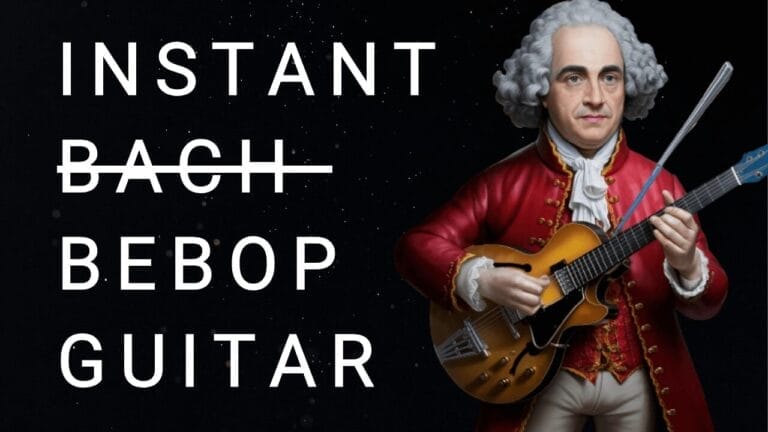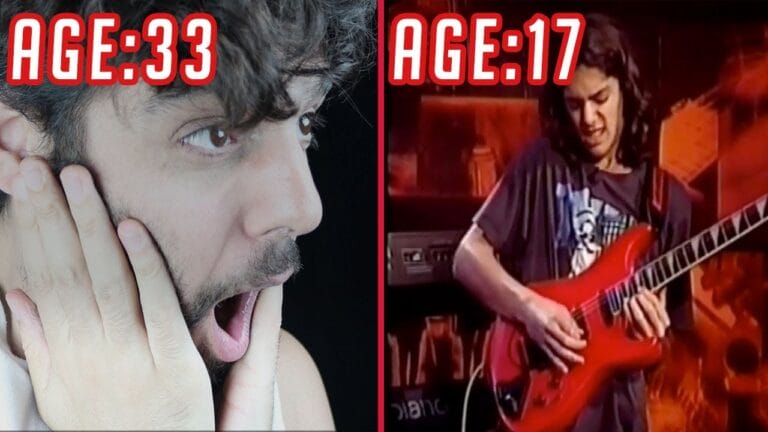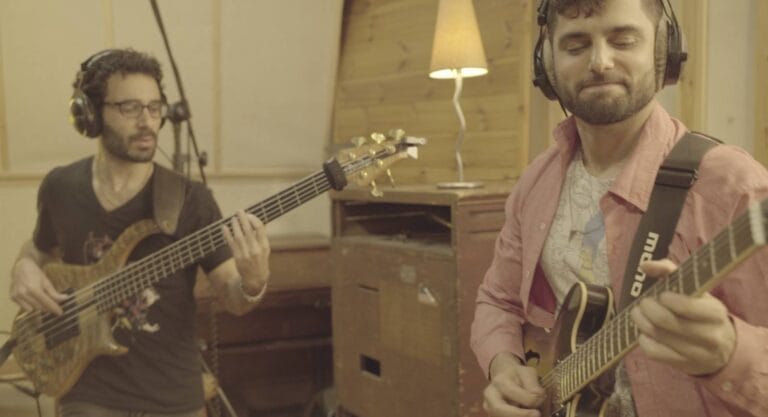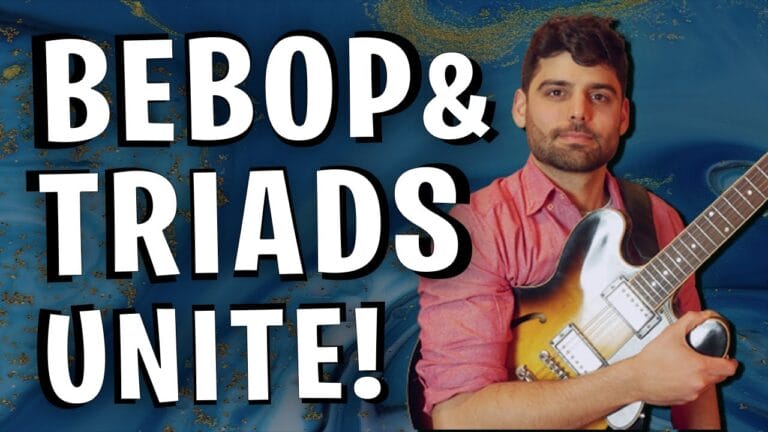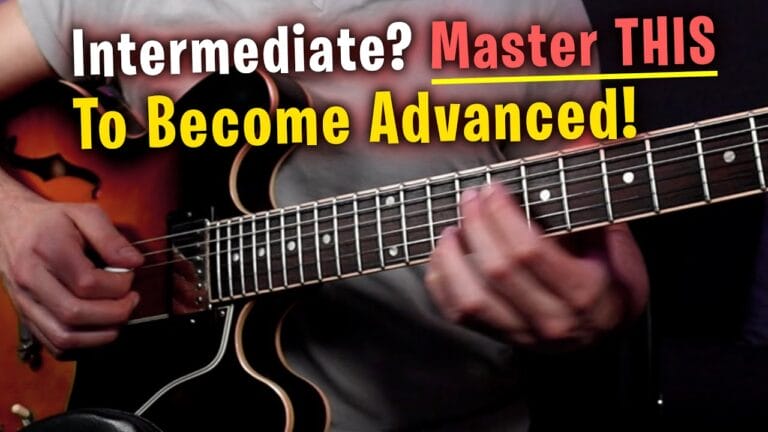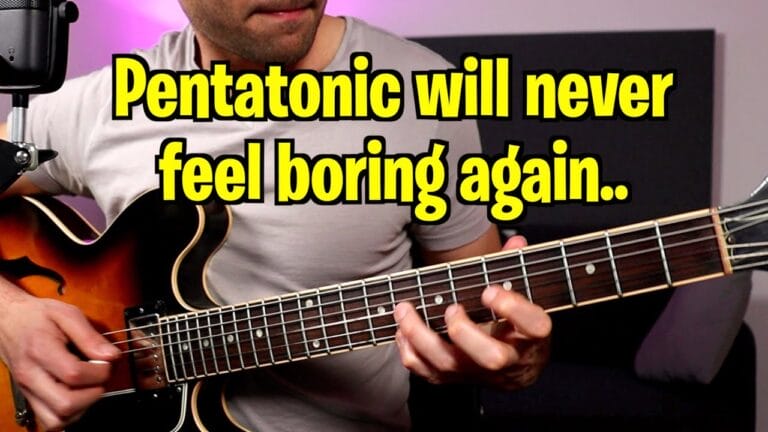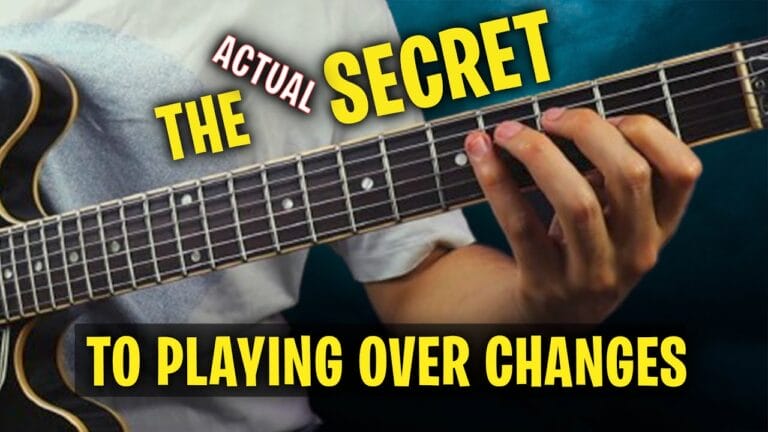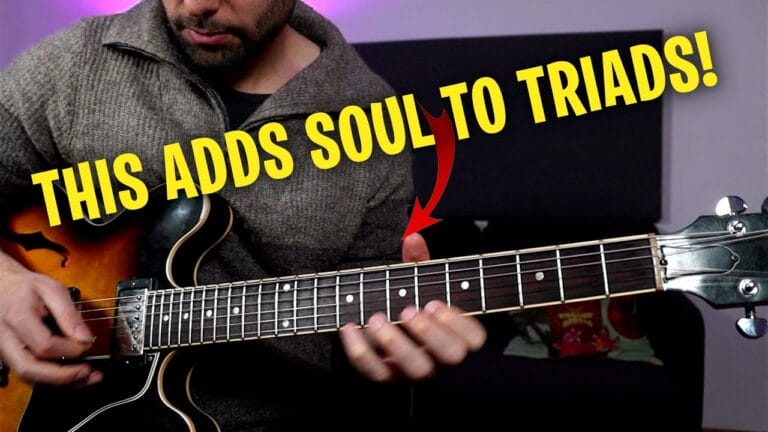The Ultimate Bebop Guitar Guide Part 1: From Basics to Mastery
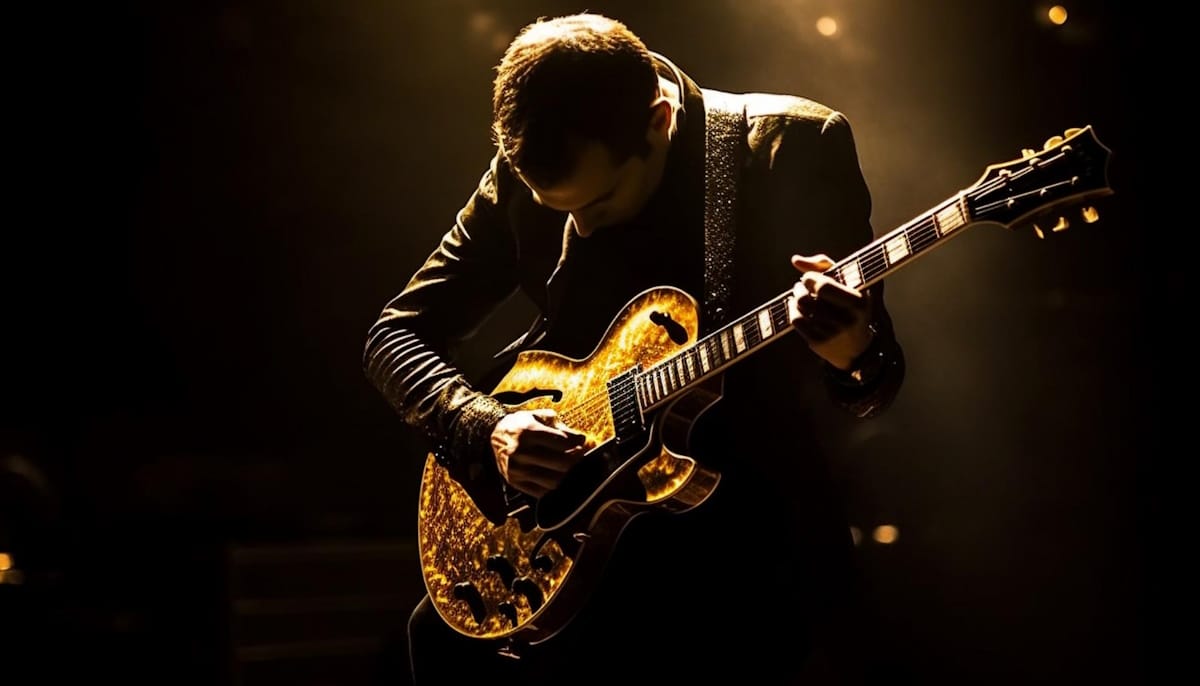
Greetings,
As we embark on this journey through the thrilling, dynamic world of bebop guitar,
I’m excited to share with you today some of my insights and techniques gathered over two decades of guitar-playing experience.
I’ve been fortunate enough to share my passion for guitar on YouTube, on my online courses, and in private lessons,
And today, I will try my best to convey to you the significance of the fundamental rhythmic, harmonic, and melodic components of Bebop guitar through a series of videos and written materials so that both inexperienced and seasoned players can confidently explore its depths.
Let’s make this journey fun and start with the basics before exploring advanced concepts!
‘Jazz is not a what, it is a how.’ – Bill Evans.
Understanding Bebop Jazz Guitar
If you want to learn how to play Bebop jazz guitar, you should listen to the music as much as possible while diving into some of its most essential elements.
First and foremost, it’s essential to learn and understand the proper techniques, such as chord tone targeting – and line construction, also known as “Playing the Changes” – and exploring relationships between triplets, sixteenth notes, and eighth notes, as well as those syncopated rhythms that make Bebop jazz come to life.
If straight ahead bop is your goal, keep in mind that swing feel is critical for capturing the authentic Bebop groove.
Key Bebop Jazz Guitarists
To name a few, classic giants of Bebop Jazz Guitar include Charlie Christian, Wes Montgomery, Jim Hall, Grant Green, and Joe Pass. Listening to their performances can provide valuable insights into more traditional bebop techniques and styles.
Beginning Your Bebop Journey
Let’s begin our Bebop Guitar lesson by understanding the essential components of this unique style.
Here are the basic building blocks:
At the very start of our journey with bebop jazz guitar,
it’s all about sparking that burning curiosity.
Take my word for it; pick up a few records that make your heart groove, and let them sweep you off your feet into the rhythms and cadences of this timeless style.
Believe me, when you can groove to the music and feel it in your bones, hear it in your head, Bebop just becomes a part of you, just like a language. -, trust me when I say that that makes the whole learning journey so much faster and more fun!
Chords:
Bebop harmony relies heavily on creating melodies over 7th chords (major, minor, and dominant), utilizing turnarounds, extended chords, and altered chords.
Imagine you’re walking down a musical path and suddenly see a turn in the road that leads you right back home. This, my friend, is a turnaround in the world of bebop tunes.
These little sidetracks pop up at the end of phrases or sections, returning you to where your chord progression kicked off.
To learn about different types of turnarounds, watch this video:
Isn’t that a fun ride?
Bebop masters treat these turnarounds like their personal playgrounds, using them to stir up some magic and add a pinch of harmonic tension to their creative outpourings.
But wait, the fun continues. Let’s move on to what we call ‘Extended Chords‘.
Now, don’t they sound fancy? Extended chords are like the secret spices of bebop harmony. Musicians enjoy sprinkling these extras – the 9th, 11th, and 13th notes— to zest up their melodies. It’s like adding an explosion of colors to their sonic painting. And hey, these added notes are not just for show; they give our bebop maestros a broader canvas to craft intricate and heart-touching melodies.
And Here’s Another Fun Part: Altered chords. Oh boy, they are the real game-changers! ‘Altered chords‘ in bebop are the harmonic spices – often, Bebop Musicians play around by tweaking specific notes, sharpening or flattening the 5th, 9th etc., adding that unexpected crunch to the recipe, and giving our beloved Bebop sounds an intriguing and delicious flavor.
‘Music gives a soul to the universe’. – Plato
Scales:
Bebop scales are major or minor with an added chromatic note, typically the b6 in major or the #5 in minor scales.
If you want to learn the basics of Bebop, here is a must-watch video!
Get familiar with melodic elements like enclosures, bebop scales, and classic chromatic techniques.
‘I’ll play it first and tell you what it is later.’ – Miles Davis.
Building Your Bebop Vocabulary
You’ve got some basics down, feeling inspired yet? Perhaps you’re craving a little more.
I get it; who doesn’t want to enrich their bebop skills ?
The secret? Listening, mimicking, and embracing the language of Bebop until it feels like second nature
Here is a quick solo over some ‘basic’ bebop harmony:
Kicking Off Your Journey with some Bebop Licks
Starting your bebop journey can feel like learning to salsa dance—tricky at first but rewarding once you get the rhythm. You can start by learning some bebop licks—those small yet potent nuggets of bebop.
They’re packed with nifty tricks like chromaticism, arpeggios, enclosures, and those all-important chord tones.
Colorful Interludes: Spicing Up Your Melodies with Chromaticism
Talking of Bebop, you can’t leave out chromaticism—it’s the cool kid in the playground. It’s all about sprinkling extra ‘zesty’ notes between your main ones. These chromatic touches are the secret ingredient that adds a hip, jazzy flavor to your melodies.
Harmonic Hugs: Sweetening Your Solos with Enclosures
Enclosures, ever heard of them?
Picture them as a warm, musical embrace for your key chord notes. Start above your target, dip below, and then resolve right back on it. This is an ingenious way to spotlight those vital chord tones and add extra panache to your solos.
Bulls-eye on Harmony: Unlocking Authenticity with Chord Notes
But if there’s one secret sauce to an authentic bebop melody, it’s all about targeting those chord notes. It’s like trying to hit the bulls-eye in darts;
only your target is those defining notes that bring harmony to life. By doing this, your tunes will sing with connectivity, rich harmony, and an authentic bebop vibe.
So, folks, if you’re ready to plunge into the bebop ocean, start with some bebop licks. Get a taste of chromaticism, deep dive into arpeggios, wrap your arms around enclosures, and aim for those chord notes. You’ll be creating some magical bebop tunes before you know it.
It is an excellent resource for learning Bebop licks.
Watch this video to learn how to create your own licks!
Harmonic Architects: Laying the Foundation with Arpeggios
Next in line— Arpeggios.
The harmony heroes in your bebop melodies create a rock-solid foundation. Like layering bricks one by one to build a sturdy wall, playing chord notes in sequence weaves a smooth, flowing musical tapestry that fits the chords like a glove.
Unlock your arpeggio mastery now – watch this:
The following exercises are based on the evergreen topic of continuity. Which can be found in almost any art form, including: Literature, dancing,songwriting, theater etc.
Playing Bebop Jazz Guitar
Having gained knowledge and honed your skills, it’s time to play Bebop Jazz Guitar.
Remember, Bebop is more than just scales and chords; it’s about expressing yourself through your instrument.
Improvisation: Bebop is mainly improvisational, so feel free to experiment and make the music your own. Consider incorporating elements of swing and blues into your playing for a more authentic bebop sound.
Rhythm: Rhythm is just as essential as melody in Bebop. Practicing with other musicians and working on your time feel with a metronome will help you become more comfortable with the various tempos and time feel typically found in Bebop.
To learn the rhythmic secrets of bebop, watch this video:
Mastering Bebop Guitar
Becoming a master of Bebop Guitar takes time and dedication, but the rewards are worth it. Build your vocabulary, refine your techniques, and explore new licks and solos.
Performance: Remember to put your skills into practice. Whether playing for friends or performing at gigs, every performance opportunity is a chance to improve.
This video showcases a live Bebop Jazz Guitar performance, giving you an idea of what to aim for.
To learn the rhythmic secrets of bebop, watch this video:
Building a Practice Routine
As the saying goes, practice makes perfect – and nowhere is this truer than mastering Bebop Jazz Guitar. Establishing a consistent practice routine will help you reinforce the skills you’ve learned and develop new ones.
Regularity: Aim for a regular practice schedule. Even if it’s just 20 minutes a day, consistent practice is more beneficial than long, sporadic sessions.
Technique Practice: Dedicate some of your practice to honing specific techniques, like fast picking, scales, and chord voicings. It will improve your skills and muscle memory.
Bebop Licks: Set aside time each session to practice different Bebop licks. Start slow and gradually increase your speed to maintain accuracy.
Transcription and Imitation: Transcribe solos from your favorite Bebop Jazz Guitar masters and try to imitate their playing. It will help you understand the genre’s unique rhythm, phrasing, and melody.
Expanding Your Bebop Repertoire
In addition to practicing Bebop Guitar, you should listen to a wide range of Bebop music to expand your repertoire.
Listen Actively: When you listen to Bebop Jazz, make it an active experience. Pay attention to the intricacies of the music, the chord changes, the improvisation, and the interaction between musicians.
Learning New Tunes: Regularly learn new bebop tunes to diversify your playing and challenge yourself. It will also give you more material to draw from during improvisation. Every jazz tune has unique lessons and challenges that help you grow as a musician.
Bebop Guitar: Challenges and Overcoming Them
Bebop Jazz Guitar can be challenging, but don’t let that discourage you.
Here are some common challenges and how to overcome them:
Speed: Bebop is often characterized by its fast tempo. Start by practicing slowly and gradually increasing your speed as you become more comfortable.
Complex Chords: Bebop features complex chord progressions that can be difficult to navigate. Take the time to study and understand these progressions, and practice arpeggiating through them.
Improvisation: Improvising can be daunting, especially in a genre as complex as Bebop. Remember, improvisation is a skill that can be learned. With practice and patience, you’ll get there!
Bebop Jazz Guitar is a fascinating style, and this comprehensive Bebop Guitar lesson should provide you with the foundation needed to dive into this rich musical world. Remember, the key to mastering Bebop lies in consistent practice, so pick up your guitar and start exploring those Bebop Licks.









